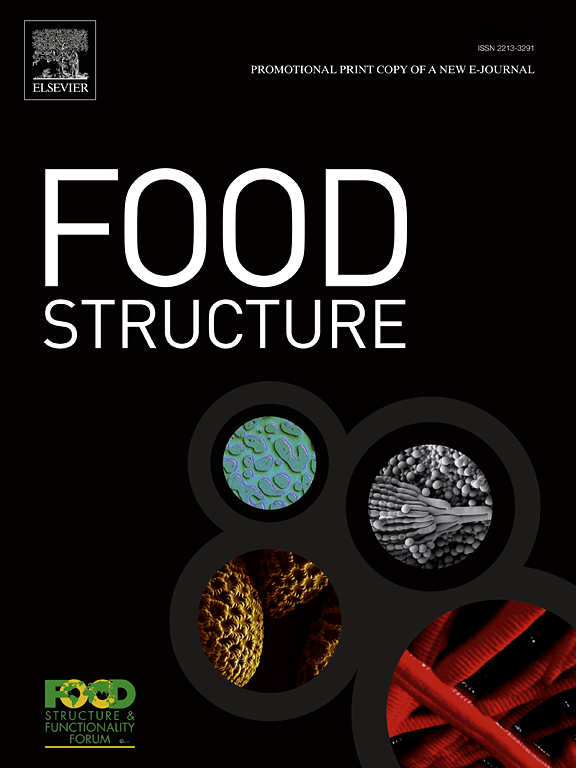Formation mechanism of thermomechanically stabilized whey protein-pectin complexes: Contribution of pectin and protein to complex structure
IF 5.6
3区 农林科学
Q1 FOOD SCIENCE & TECHNOLOGY
引用次数: 0
Abstract
Whey protein pectin complexes (WPPC) processed at the technical scale in the particle size range of 1–40 µm have the potential to be utilized as fat replacers. WPPC are formed via thermomechanical treatment at a specific pH level, which allows for the interaction between the biopolymers. In the pH range of 4.75 to 5.75, whey protein and pectin form coacervates or soluble complexes. The diverse interactions result in WPPC with particle sizes d3.2 between 0.2 and 40 µm after thermomechanical treatment on a scraped surface heat exchanger. The pectin contributes to the WPPC structure in three distinct forms, dependent on the pH, as determined via mass balance. The pectin is present in three forms: (i) 50–80 % free, (ii) 15–30 % electrostatically stabilized, and (iii) 5–10 % incorporated pectin. Approximately 20 % of the whey protein with particle sizes below 1 µm was electrostatically stabilized. The addition of pectin-degrading enzymes resulted in a multimodal particle size distribution, indicating that pectin is connecting larger aggregate structures. Based on the core-shell model, a revised model for the WPPC formation at the technical scale on a scraped surface heat exchanger is proposed.
热机械稳定的乳清蛋白-果胶复合物的形成机制:果胶和蛋白质对复合物结构的贡献
乳清蛋白-果胶配合物(WPPC)在1-40 µm的技术规模范围内具有作为脂肪替代品的潜力。WPPC是通过在特定pH值下的热机械处理形成的,这允许生物聚合物之间的相互作用。在4.75 ~ 5.75的pH范围内,乳清蛋白和果胶形成凝聚体或可溶性复合物。不同的相互作用导致刮削表面换热器经过热处理后得到粒径d3.2在0.2 ~ 40 µm之间的WPPC。果胶对WPPC结构的贡献有三种不同的形式,取决于pH值,通过质量平衡来确定。果胶以三种形式存在:(i) 50-80 %游离,(ii) 15-30 %静电稳定,(iii) 5-10 %掺入果胶。粒径小于1 µm的乳清蛋白中约有20% %是静电稳定的。果胶降解酶的加入导致了多模态粒度分布,表明果胶连接了更大的聚集体结构。在核壳模型的基础上,提出了刮削表面换热器技术尺度下WPPC形成的修正模型。
本文章由计算机程序翻译,如有差异,请以英文原文为准。
求助全文
约1分钟内获得全文
求助全文
来源期刊

Food Structure-Netherlands
Chemical Engineering-Bioengineering
CiteScore
7.20
自引率
0.00%
发文量
48
期刊介绍:
Food Structure is the premier international forum devoted to the publication of high-quality original research on food structure. The focus of this journal is on food structure in the context of its relationship with molecular composition, processing and macroscopic properties (e.g., shelf stability, sensory properties, etc.). Manuscripts that only report qualitative findings and micrographs and that lack sound hypothesis-driven, quantitative structure-function research are not accepted. Significance of the research findings for the food science community and/or industry must also be highlighted.
 求助内容:
求助内容: 应助结果提醒方式:
应助结果提醒方式:


